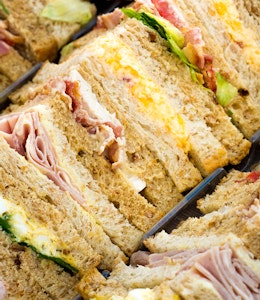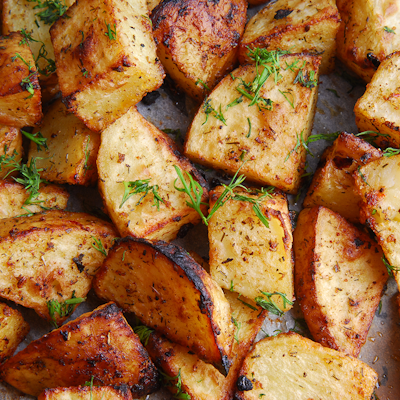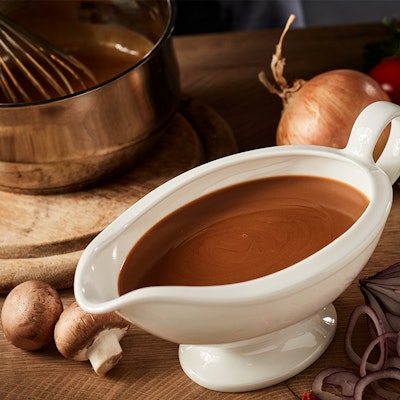Cured meats list
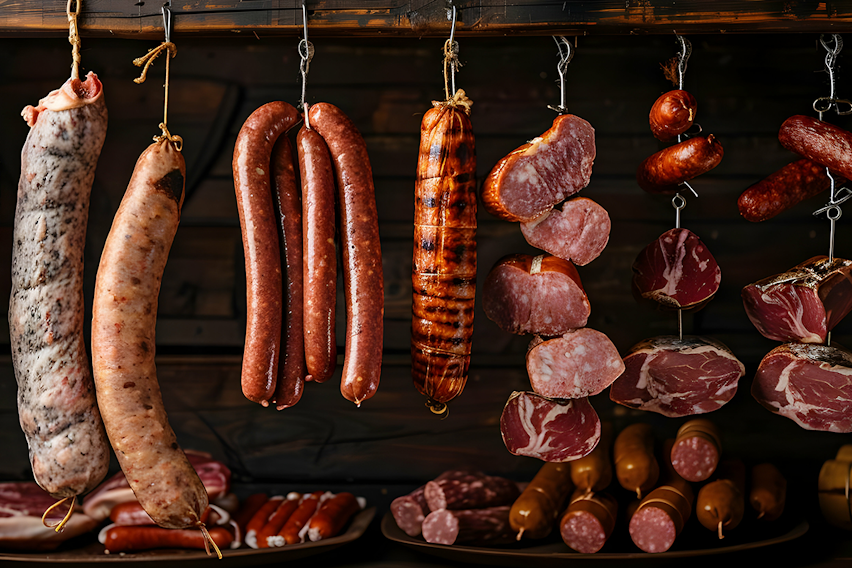
Cured meats can be eaten raw or cooked, making them one of the most versatile ingredients to have in your kitchen cupboard (another great thing about cured meats is that they can be stored at room temperature). So we’ve compiled this round-up of the best cured meats for all kinds of dishes (and whether they contain gluten or allergens too)...
Here’s the list of the best cured meats:
- Salami
- Prosciutto
- Pancetta
- Chorizo
- Speck
- Pepperoni
- Bresaola
- Iberian Ham
Now let’s find out more about them...
Salami
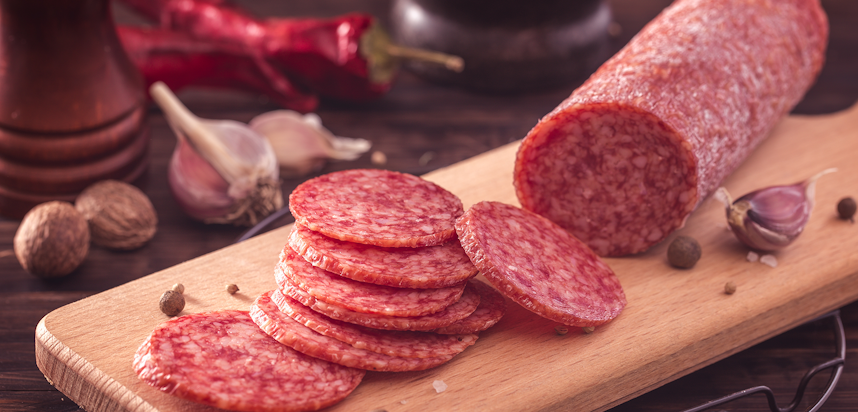
What is salami?
Salami is a type of cured sausage, usually made from pork (but sometimes other meats such as beef, lamb or even game). With ingredients typically including pork, garlic, salt, vinegar, minced fat and sometimes wine, spices and herbs, the sausage is fermented and air-dried. A large part of salami’s distinctive flavour comes from the large chunks of fat throughout the sausage - in fact up to around 70% of a salami sausage can be fat.

Salami can be stored at room temperature for up to 45 days, making it an economical choice for when meat is scarce, and historically was consumed by peasants.
How to use salami
Salami is a popular component of charcuterie boards and goes particularly well with cheese (especially gouda and emmental) - making it a great pizza topping and sandwich ingredient. Salami also pairs well with dates and other rich fruits. As a meat that shreds easily, you can also mix it effectively into scrambled eggs or even polenta.
Top tip
If not stored correctly, salami can become slimy. As a cured, shelf-stable meat, whilst it does not need to be kept chilled, keeping it somewhere warm can deprive it of the air it needs and suffocate it - leading to the sliminess.
Therefore, for best results wrap it in greaseproof paper and store in a cool, dry place - or the fridge.
What is considered a cured meat?
A meat is considered cured if it has been preserved through brining (where the meat is submerged in water with the addition of salt or other additives for several days) - known as wet curing, or covered with a dry rub or salt and air dried, sometimes for months at a time - known as dry curing. A lot of cured meats are also smoked after this process.
Prosciutto
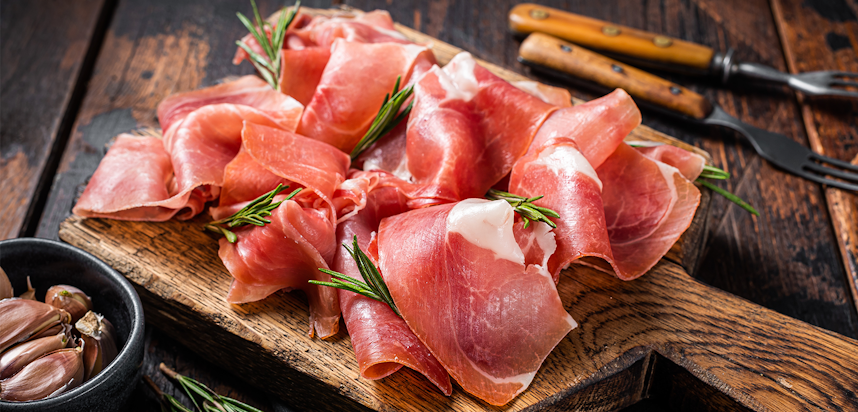
What is prosciutto?
Often referred to by its full name of prosciutto crudo, prosciutto is an unsmoked, dry-cured ham, usually served uncooked and thinly sliced. Salty but with a delicate sweetness, like bacon prosciutto is streaked with fat, but it is lower in calories and fat than bacon. It is made from the hind legs of the pig, and takes around a year to cure properly - sometimes being flavoured with pepper, garlic or spices in the process.
Prosciutto di Parma is a prosciutto famed for its high quality, and is an artisanal product that has to earn certified PDO (Protected Designation of Origin) status through quality control inspection stamps and markings and traceability at every stage of the production process.
How to use prosciutto
In addition to being one of the most popular and visible parts of a charcuteries board, prosciutto is a popular choice for many starters - such as prosciutto-wrapped asparagus, or serving it alongside grilled peaches or nectarines. It can also be used in salads, alongside ingredients such as melon, peas and mozzarella cheese, or on a white sauce pizza along with rocket.
Top tip
Whilst bacon is often served with the fat trimmed off, the same should not be done to prosciutto - it should be served with a ring of fat around the sides to keep the flavour.
Why do you cure meat?
Meat is cured to preserve it and make it last longer - without spoiling. The curing process prevents the growth of microorganisms that cause food poisoning, and has been used for this purpose for thousands of years (and was particularly necessary before the invention of refrigeration).
Pancetta
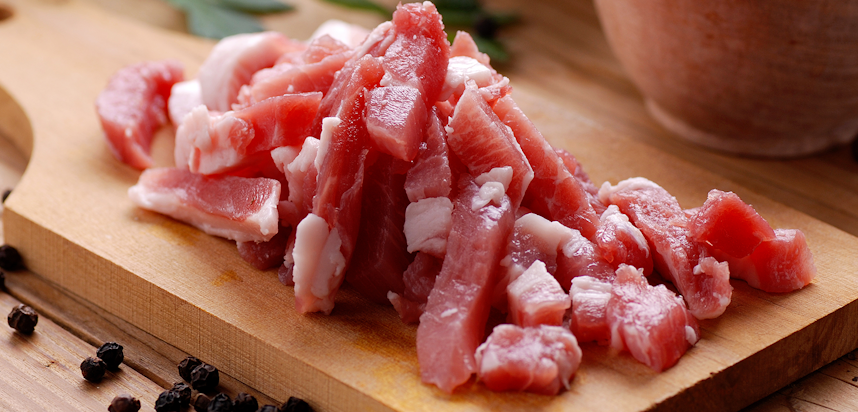
What is pancetta?
Sometimes described as “Italian bacon”, pancetta is a meat product similar to bacon, and also comes from the belly of a pig. Unlike bacon, which should be cooked before eating, pancetta is rolled into a cylinder shape and cured with salt and then smoked before being sliced.
Pancetta comes in 2 different types - arrotolata (rolled), which is cut into thin slices and eaten raw, and stesa (flat), which is chopped into cubes or sliced into thick strips (like bacon) and is used for cooking, or eaten fried or grilled.
How to use pancetta
Pancetta can be eaten raw and thinly sliced in sandwiches or as an antipasti or part of a charcuterie board. It can also be used as ingredient in cooked pasta dishes such as carbonara or even macaroni cheese - as its saltiness cuts through the cream. It can also be chopped and used in the base for tomato sauces, ragus, soups and stews.
Top tip
Fry pancetta cubes till crispy and then use in salad in place of croutons to add a new flavour dimension.
Are cured meats bad for you?
Some cured meats are fatty, and this can make them high in calories and saturated fats, though other cured meats such as bresaola are lean and high in protein. Cured meats are typically cured by introducing nitrates or nitrites to them, and whilst ingesting large amounts of nitrates and nitrites can be harmful to the body, the limited amount of them in cured meats is not considere to be dangerous.
Chorizo
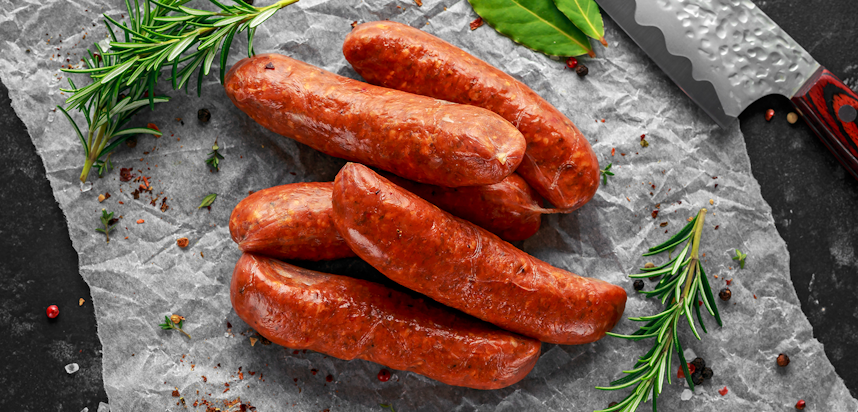
What is chorizo?
Originating from the Spanish and Portuguese region of the Iberian Peninsula, chorizo is a type of pork sausage most commonly associated with Spanish cuisine. In chorizo roughly chopped pork is mixed with pork fat and seasonings that can vary, but nearly always include paprika and garlic. The mixture is then placed in a natural casing before being left to cure and dry out.
Chorizo takes its flavour and red colour primarily from the paprika, a smoky and mildly hot spice made from dried red peppers, though in Mexico chorizo is made with chilli peppers rather than paprika.
Paprika is a cured meat that can be eaten raw, but is commonly eaten grilled or fried.
How to use chorizo
Chorizo is incredibly versatile and is a popular filling for sandwiches, wraps and paninis - both ambient and toasted, as well as being used as a pizza topping. Chorizo can be used instead of sausage meat in a sausage roll, and in place of or in addition to ground beef in a burger. Cubed or diced chorizo is also a common cooking ingredient in pasta bakes, and alongside beans and tomatoes in a stew. Some people put chorizo in paella, but it is not part of a traditional paella recipe and is even frowned upon by many authorities on Spanish cuisine.
Top tip
Chorizo is often fried, and leaves the oil it has been fried in full of rich, mildly spicy flavour (owing to the rendered fat). The chorizo oil can then be used to cook other things in (onions, diced potatoes, rice).
Can you eat cured meats during pregnancy?
Whilst cured meats usually get rid of the food-poisoning causing bacteria during the curing process and consequently eaten raw, there is a chance they may still contain toxoplasmosis-causing parasites. For this reason pregnant women are advised to avoid cured meats unless they have been cooked through and are served whilst still hot.
Speck
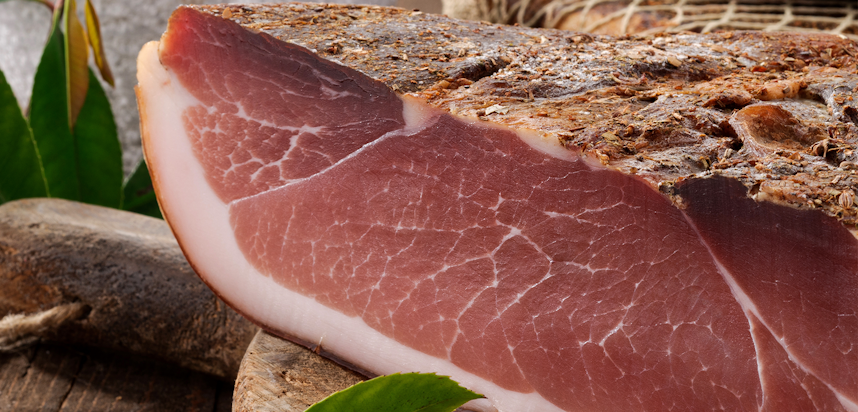
What is speck?
Speck is typically a salted, air-cured type of pork, but the name may refer to several different European cured pork products.
Do cured meats contain gluten?
Some cured meats, particularly those with multiple additional ingredients, may contain cereals like wheat or rye, and therefore gluten.
With any processed meat it is best to check the ingredients label to ensure that there are no Cereals containing Gluten in there.
Speck is very often made from pork leg, and smoked but the fat content can vary - German speck is predominantly pickled pork fat, whilst Dutch speck is essentially just bacon. You can get rump speck, fillet speck and loin speck, and much of the speck sold in the UK is similar to pancetta, though smokier, owing to the process used to make it.
How to use speck
As a cured meat, speck can be eaten raw and is generally sliced very thin, making it a good choice for sandwiches, as well as charcuterie and antipasti, or wrapped around dates or asparagus as a starter or canape.
Speck can also be used in place of bacon in several dishes, especially creamy pastas such as mushroom pappardelle, or cauliflower cheese, raclette or as a filling in dumplings.
Top tip
When slicing speck, for best results, slice against the fibre.
Pepperoni
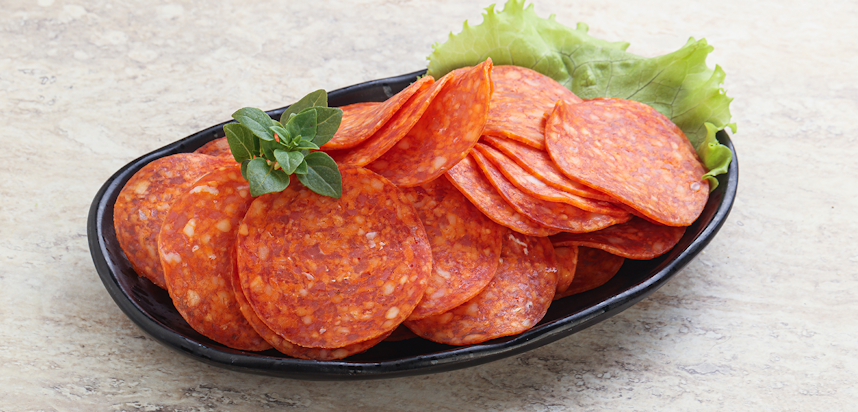
What is pepperoni?
Pepperoni is a cured meat often associated with pizza, and considered by many as a dry Italian salami, with more spices.
Pepperoni can be made from a variety of meats, but is usually a combination of pork and beef, or pork, beef and chicken, or sometimes turkey, with the addition of spices such as paprika, crushed red pepper, garlic powder, and mixed herbs. It is cured with nitrates or nitrites, and needs to hang and mature for at least 6 weeks before it is ready to eat. While safe to eat raw, when it has a soft consistency and spicy flavour, pepperoni is more popularly eaten cooked and crispy.
How to use pepperoni
Pepperoni is one of the most popular pizza toppings, particularly in American-style pizza. It can also be used as a toastie or panini filling, in savoury baked goods, on top of loaded fries and nachos, and even as an ingredient in pasta bakes.
Top tip
Pepperoni is delicious when heated, but it can be very oily and make the food it is served with oily too. One way to combat this is to place pepperoni slices on a paper towel on a plate and cook in the microwave for a high heat for a minute. The paper towel will absorb much of the pepperoni’s oil, and it can then be added to pizza or other foods.
Bresaola

What is bresaola?
Bresaola is a type of Italian cured, salted beef that has been air-dried in either a naturally dry or artificially dry environment and aged, then sliced extremely thin and served raw.
Hard in texture and dark red in colour, bresaola is made from the round cut of the cow, with very thin lines of fat running through it. Because it is so lean, it is one of the healthiest types of cured meat, and also full of iron and protein. Bresaola is usually served at room temperature, or even slightly chilled.
How to use bresaola
Bresaola is typically served as an antipasti, drizzled in olive oil and lemon juice, and frequently alongside a salad made with rocket and parmesan cheese, olives and even nuts. You can also use bresaola as a sandwich meat, as it pairs well with crusty white bread.
Are cured meats an allergen?
No, cured meats in principle are not among the 14 major food allergens. However, some cured meats may contain small amounts of Cereals containing Gluten (such as wheat or rye) - which is a major allergen, so it is always best to check the ingredients label.
Top tip
To avoid hard, chewy bresaola and preserve the soft and tender texture, store it wrapped in a cotton or muslin cloth to prevent too much moisture escaping.
Iberian Ham
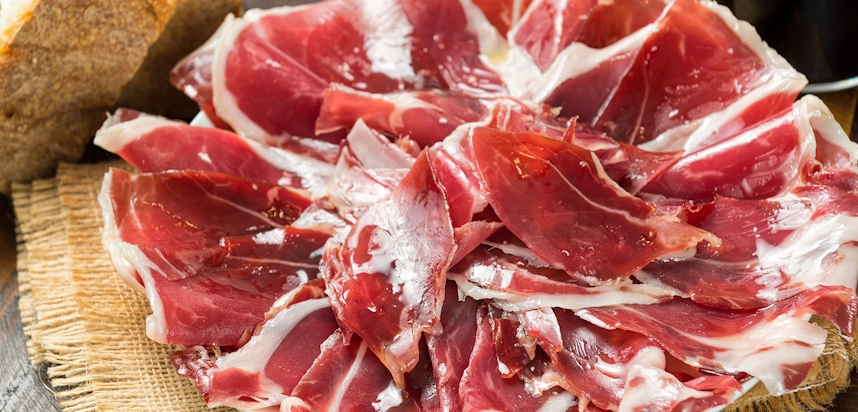
What is Iberian ham?
Frequently known by the Spanish “jamón ibérico” or Portuguese “presunto ibérico”, Iberian is a type of cured pork made from the leg of Black Iberian pigs and produced in Spain and Portugal, in the Iberian Peninsula. Iberian ham is known for its juicy, melt-in-the-mouth consistency and slightly nutty, earthy flavour. This is due to the breed of pig it is made from - black pigs, which are different to other pigs and since the 2014 standard, are called Pata Negra. These pigs are native only to areas of Portugal and central and southern Spain, whose forests provide the pigs with a diet of acorns and other botanicals that give the ham its distinctive flavour.
How to use Iberian ham?
Traditionally Iberian ham is served simply, sliced and with fresh bread and tomatoes, as part of a charcuterie board or as a tapas dish. You can also eat Iberian ham with fruits like peaches, or alongside poached or scrambled eggs as a breakfast dish.
Top tip
Because of its distinctive monounsaturated fats, Iberian ham pairs unexpectedly and particularly well with cava or other sparkling, dry wines. Serve it as a nibble or antipasti alongside drinks or at a wine tasting.
You may also be interested in…


You may also be interested in…
What is the best replacement for meat?
ReadYou may also be interested in…
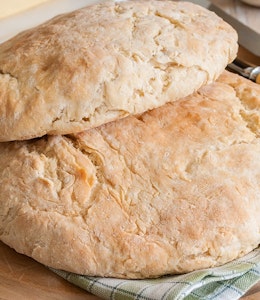
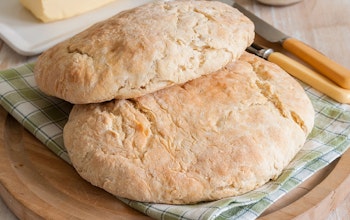
You may also be interested in…
